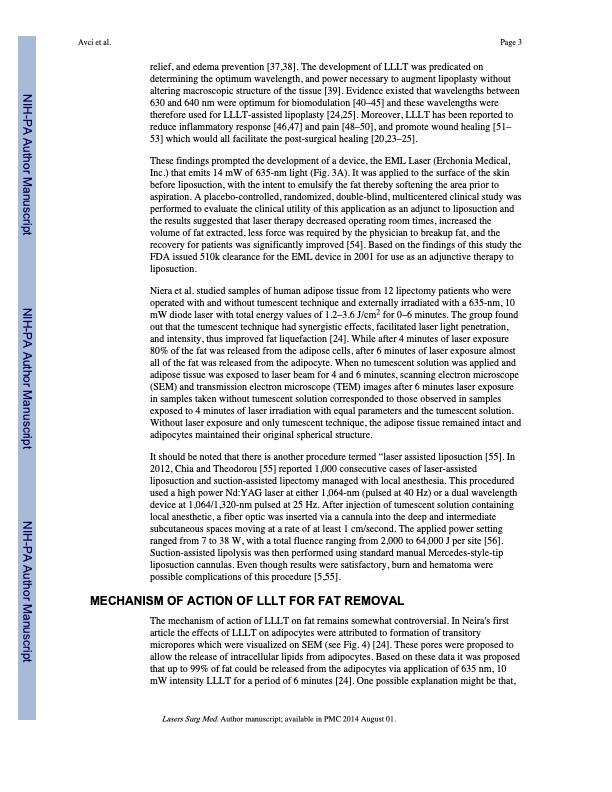
PDF Publication Title:
Text from PDF Page: 003
Avci et al. Page 3 relief, and edema prevention [37,38]. The development of LLLT was predicated on determining the optimum wavelength, and power necessary to augment lipoplasty without altering macroscopic structure of the tissue [39]. Evidence existed that wavelengths between 630 and 640 nm were optimum for biomodulation [40–45] and these wavelengths were therefore used for LLLT-assisted lipoplasty [24,25]. Moreover, LLLT has been reported to reduce inflammatory response [46,47] and pain [48–50], and promote wound healing [51– 53] which would all facilitate the post-surgical healing [20,23–25]. These findings prompted the development of a device, the EML Laser (Erchonia Medical, Inc.) that emits 14 mW of 635-nm light (Fig. 3A). It was applied to the surface of the skin before liposuction, with the intent to emulsify the fat thereby softening the area prior to aspiration. A placebo-controlled, randomized, double-blind, multicentered clinical study was performed to evaluate the clinical utility of this application as an adjunct to liposuction and the results suggested that laser therapy decreased operating room times, increased the volume of fat extracted, less force was required by the physician to breakup fat, and the recovery for patients was significantly improved [54]. Based on the findings of this study the FDA issued 510k clearance for the EML device in 2001 for use as an adjunctive therapy to liposuction. Niera et al. studied samples of human adipose tissue from 12 lipectomy patients who were operated with and without tumescent technique and externally irradiated with a 635-nm, 10 mW diode laser with total energy values of 1.2–3.6 J/cm2 for 0–6 minutes. The group found out that the tumescent technique had synergistic effects, facilitated laser light penetration, and intensity, thus improved fat liquefaction [24]. While after 4 minutes of laser exposure 80% of the fat was released from the adipose cells, after 6 minutes of laser exposure almost all of the fat was released from the adipocyte. When no tumescent solution was applied and adipose tissue was exposed to laser beam for 4 and 6 minutes, scanning electron microscope (SEM) and transmission electron microscope (TEM) images after 6 minutes laser exposure in samples taken without tumescent solution corresponded to those observed in samples exposed to 4 minutes of laser irradiation with equal parameters and the tumescent solution. Without laser exposure and only tumescent technique, the adipose tissue remained intact and adipocytes maintained their original spherical structure. It should be noted that there is another procedure termed “laser assisted liposuction [55]. In 2012, Chia and Theodorou [55] reported 1,000 consecutive cases of laser-assisted liposuction and suction-assisted lipectomy managed with local anesthesia. This procedured used a high power Nd:YAG laser at either 1,064-nm (pulsed at 40 Hz) or a dual wavelength device at 1,064/1,320-nm pulsed at 25 Hz. After injection of tumescent solution containing local anesthetic, a fiber optic was inserted via a cannula into the deep and intermediate subcutaneous spaces moving at a rate of at least 1 cm/second. The applied power setting ranged from 7 to 38 W, with a total fluence ranging from 2,000 to 64,000 J per site [56]. Suction-assisted lipolysis was then performed using standard manual Mercedes-style-tip liposuction cannulas. Even though results were satisfactory, burn and hematoma were possible complications of this procedure [5,55]. MECHANISM OF ACTION OF LLLT FOR FAT REMOVAL The mechanism of action of LLLT on fat remains somewhat controversial. In Neira's first article the effects of LLLT on adipocytes were attributed to formation of transitory micropores which were visualized on SEM (see Fig. 4) [24]. These pores were proposed to allow the release of intracellular lipids from adipocytes. Based on these data it was proposed that up to 99% of fat could be released from the adipocytes via application of 635 nm, 10 mW intensity LLLT for a period of 6 minutes [24]. One possible explanation might be that, Lasers Surg Med. Author manuscript; available in PMC 2014 August 01. NIH-PA Author Manuscript NIH-PA Author Manuscript NIH-PA Author ManuscriptPDF Image | Low-Level Laser Therapy for Fat Layer Reduction

PDF Search Title:
Low-Level Laser Therapy for Fat Layer ReductionOriginal File Name Searched:
nihms-509305.pdfDIY PDF Search: Google It | Yahoo | Bing
Cruise Ship Reviews | Luxury Resort | Jet | Yacht | and Travel Tech More Info
Cruising Review Topics and Articles More Info
Software based on Filemaker for the travel industry More Info
The Burgenstock Resort: Reviews on CruisingReview website... More Info
Resort Reviews: World Class resorts... More Info
The Riffelalp Resort: Reviews on CruisingReview website... More Info
| CONTACT TEL: 608-238-6001 Email: greg@cruisingreview.com | RSS | AMP |